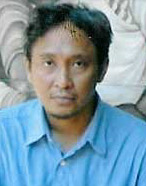 |
||
|---|---|---|
| CP Foundation | About CP Biennale | 2003 | 2005 | Contact Us | >||
           
|
||
|
Adi's facial reconstruction seems to have given forms to the traumatic experience of seeing (and hearing) the fleeting arrival of the thousands of faces They appear simultaneously, incessantly, directly in-your-face, without the slightest regards to the viewers and listeners. Their appearance is always followed with various aims and goals, ranging from the entertaining to the political. Their mouths (and images) say meaningless words that no longer create a lucid, straight way. As Roland Barthes had once stated, all icons--especially electronically devised icons and imagery--in the form of printed pictures have their own ideologically loaded rhetoric. Anything, therefore, becomes political. In a dark labyrinth, we see how people are jailed behind a rusted iron door. We can only look at them through small openings, and it seems that these people have been silenced and permanently sentenced, turning into frightening monsters, distributing sins to the public. At least that is how Adi sees them. Adi appears to be on the side of the eternally marginalized and displaced by the hypocritical regimes; regimes who continually oversupply us with boring promises and rhetoric. The sins of the regimes flow in the veins of the nation. Adi's work markedly signifies how art has a special, truthful task to carry out, although it is still marginalized and not understood by many. The artists, however, must be able to read and understand the people's inner voices. Born in Surabaya, March 22, 1964. SELECTED GROUP EXHIBITIONS |
||
|
CP Foundation | About CP Biennale | 2003 | 2005 | Contact Us
Jl. Suryopranoto 67A, Jakarta 10160, Indonesia. ph. +62.21.3448126, 3853206 | fax. +62.21.3853203, 3853208 info@cp-foundation.org |
||
 The contemporary public life has been bombarded by the abundant audio-visual information. The latest developments of the print and electronic media-capitalism have enabled the information to seep through many cultural and geographic barricades. In such chaotic atmosphere of overflowing information, the existence of a single, powerful truth becomes highly doubtful. Perhaps what has become more probable is precisely the emergence of the various stereotypes, due to the arbitrary, massive acceptance of the information.
The contemporary public life has been bombarded by the abundant audio-visual information. The latest developments of the print and electronic media-capitalism have enabled the information to seep through many cultural and geographic barricades. In such chaotic atmosphere of overflowing information, the existence of a single, powerful truth becomes highly doubtful. Perhaps what has become more probable is precisely the emergence of the various stereotypes, due to the arbitrary, massive acceptance of the information.